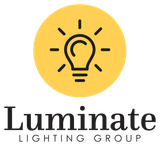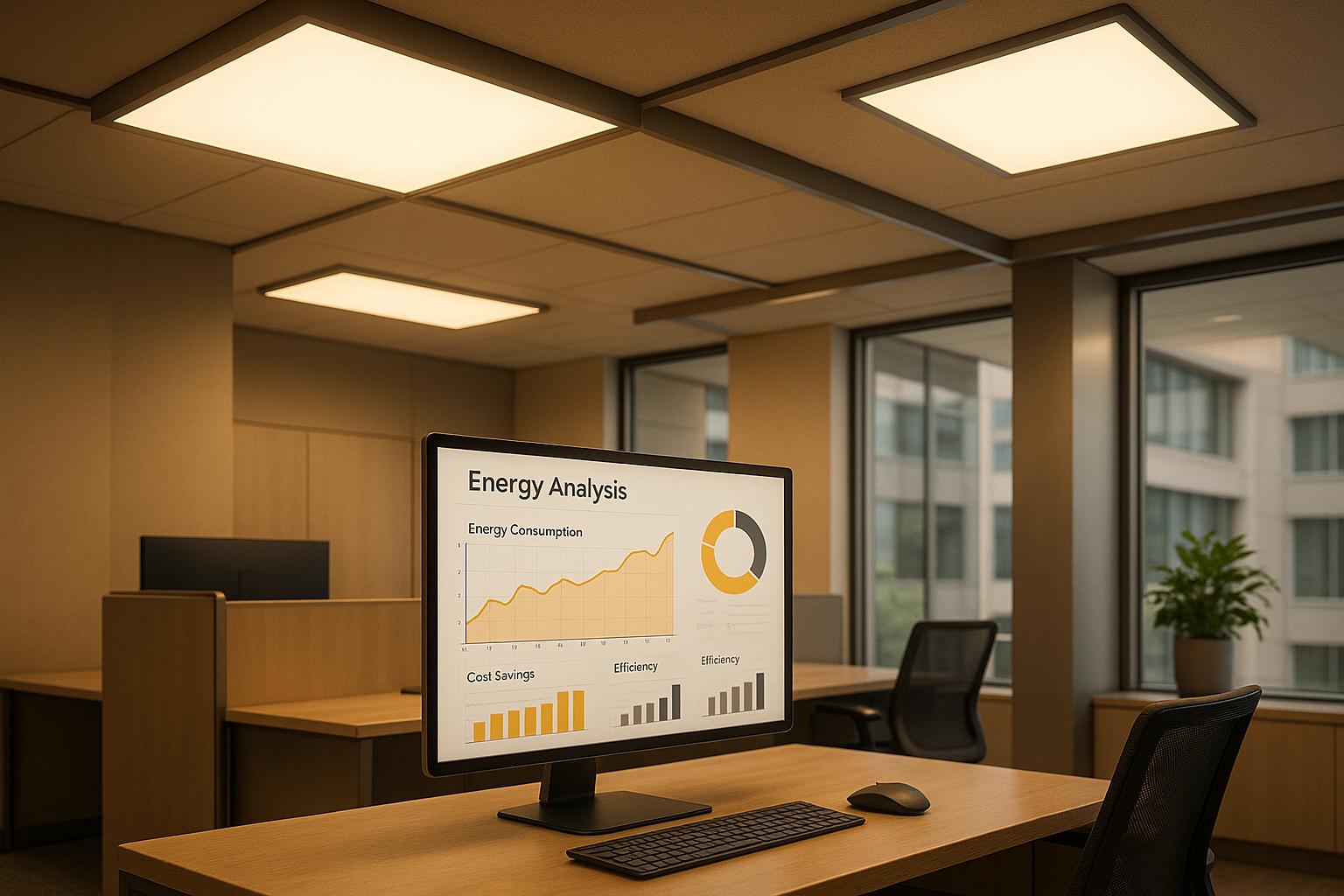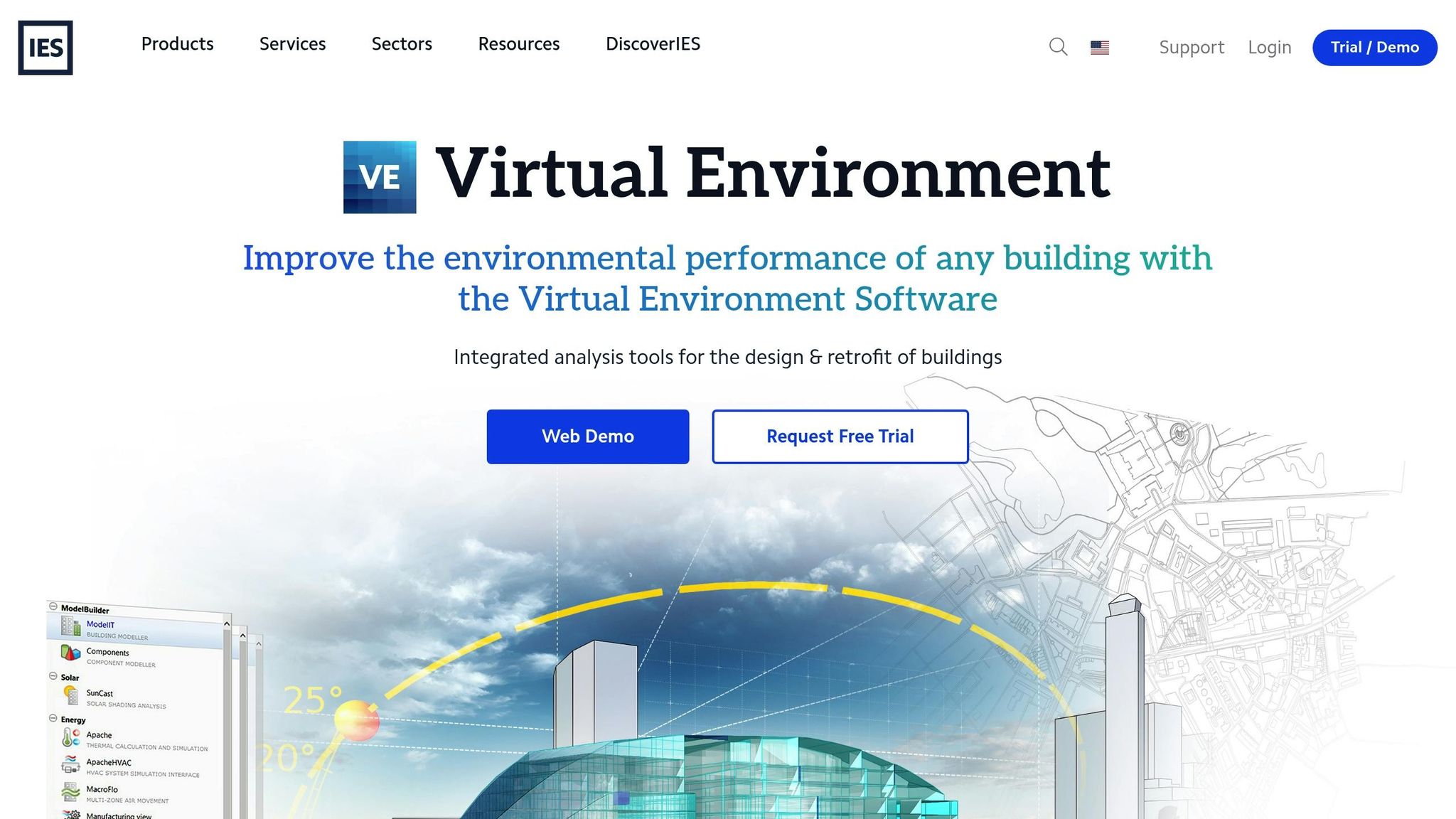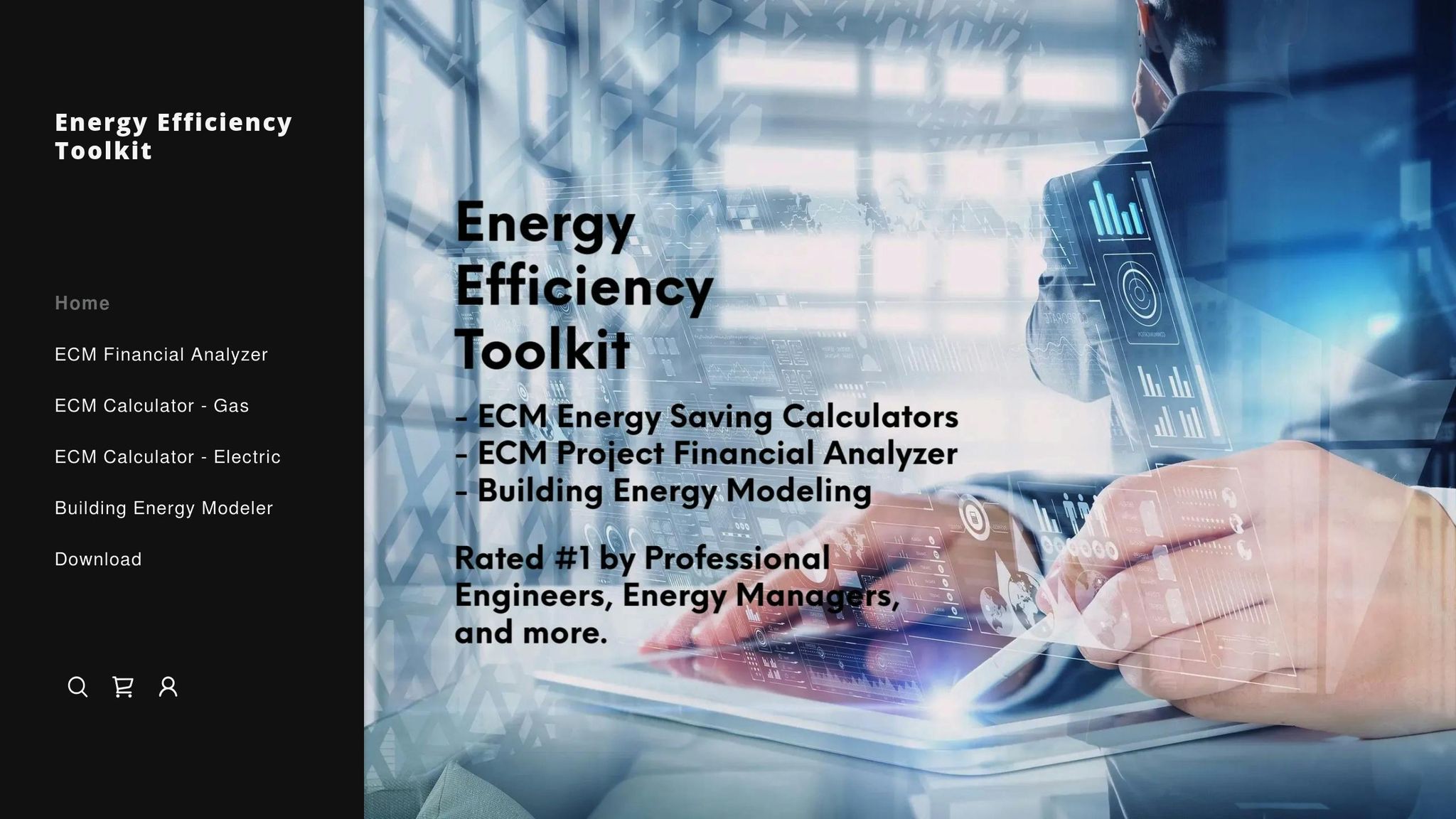Explore essential energy analysis tools for LED retrofits, enhancing savings and compliance while simplifying project management.


Switching to LED lighting can reduce energy usage by 50–80%, but skipping an energy analysis can lead to missed savings and incentives. Tools like ecoInsight Retrofit Software, IES Virtual Environment (IESVE), and the Energy Efficiency Tool Kit simplify this process by calculating savings, modeling upgrades, and supporting compliance with U.S. energy codes. For large or complex projects, professional services like Luminate Lighting Group provide tailored assessments and manage rebate applications, ensuring maximum financial benefits.
Key takeaway: Choose tools or services based on project size, complexity, and required precision to maximize ROI and energy savings.

ecoInsight Retrofit Software is a tool tailored for managing commercial and industrial LED retrofit projects. By digitizing lighting audits, it eliminates the need for tedious manual data entry and minimizes errors. This streamlined process lays the groundwork for precise energy analysis.
The software collects key details such as fixture types, operating schedules, and energy consumption patterns. With this data, it calculates potential energy savings and generates in-depth reports that highlight energy usage and cost reductions. These reports provide facility managers with a solid framework to assess the value of LED retrofit projects.

IESVE is a robust energy analysis tool designed to evaluate a building's overall energy performance, including lighting, heating, and cooling systems. It’s especially useful for accurately predicting energy savings from LED retrofits, thanks to its specialized simulation modules.
With its advanced modeling tools, IESVE can simulate various elements like lighting, thermal comfort, and HVAC systems all at once. For LED retrofits, it allows users to model current lighting setups and test proposed upgrades to estimate potential energy savings. To ensure accurate results, the software requires detailed input data, such as fixture specifications and operational schedules. Beyond lighting, IESVE evaluates how changes in one system might impact others, providing a complete picture of a building's energy demands.
IESVE integrates seamlessly with Building Information Modeling (BIM) platforms, including Autodesk Revit. This feature enables users to import building geometry and lighting layouts directly into the software. By doing so, project teams can update lighting designs, run detailed simulations, and generate reports more efficiently throughout the retrofit process.
The software also includes modules tailored for compliance with key U.S. energy standards, such as ASHRAE 90.1 and the International Energy Conservation Code (IECC). These modules help generate the required documentation and simulation data for code submissions, ensuring that LED retrofit designs meet or exceed regulatory benchmarks. For projects aiming for LEED certification, IESVE provides comprehensive energy modeling documentation to support sustainability objectives.
Although IESVE delivers highly detailed and accurate analyses, it does require expertise to operate effectively. Additionally, simulations for large or complex buildings may take longer to process. Still, for in-depth retrofit evaluations, it remains a powerful tool for achieving precise and reliable results.

The Energy Efficiency Tool Kit brings together various assessment methods into a single, easy-to-use platform. It’s designed to help facility managers and contractors evaluate opportunities for LED retrofits using detailed and thorough assessments.
This initial data collection lays the groundwork for accurate modeling and well-targeted retrofit strategies.
This tool captures essential details like fixture specifications, operating schedules, and power consumption patterns, creating a baseline for understanding current energy use. With this data, the tool can generate models that predict the potential benefits of switching to LED lighting. Some platforms go a step further, simulating lighting zones and incorporating factors such as daylight harvesting and occupancy patterns, enabling more tailored retrofit solutions.
The tool simplifies the retrofit process by connecting site assessments, planning, and evaluation into a cohesive workflow. It generates detailed retrofit specifications and aligns projected energy savings with real-world installation requirements. This integrated approach ensures more informed decision-making throughout the project, improving both planning precision and the transition from assessment to implementation.

Luminate Lighting Group kicks off its process with a free on-site lighting assessment and energy audit. This step identifies existing fixtures, pinpoints inefficiencies, and calculates potential energy savings. The insights gathered here lay the groundwork for creating tailored LED retrofit solutions with precise savings estimates. From this initial evaluation, the process naturally transitions into the design and installation phases.
At every step of their LED retrofit services, energy analysis takes center stage. The data collected during the assessment informs the custom lighting design process, which includes creating photometric layouts and determining fixture specifications. This ensures a smooth progression from design and permitting to installation and even utility rebate processing. Licensed electricians handle the installations, making sure they meet all code requirements while delivering the promised energy savings.
Adhering to U.S. standards is a top priority for Luminate Lighting Group. Their licensed electricians oversee every technical detail during installation to ensure full compliance with both local and national codes.
"Our licensed electricians ensure full code compliance and minimal disruption to your operations."
Additionally, the company streamlines the permitting process, managing all necessary documentation to meet regulatory standards.
Luminate Lighting Group doesn’t stop at energy savings - they also aim to maximize financial benefits. As part of their thorough assessment, they identify and pre-qualify applicable utility rebates. Their team takes care of all the paperwork required for rebate submissions, ensuring clients receive reimbursements without the hassle. Each custom LED lighting proposal includes detailed energy savings projections along with rebate opportunities, offering a clear financial overview and helping clients maximize their return on investment.
Let’s dive into the strengths and challenges of these tools and services to better understand how they cater to different project needs. By weighing these factors, facility managers and contractors can make informed decisions tailored to their specific goals and constraints.
IES Virtual Environment (IESVE) offers robust energy modeling capabilities and advanced simulation features like daylighting, HVAC integration, and renewable energy analysis. It also supports BIM interoperability, which allows for smooth collaboration between design teams and engineers. Its detailed performance analysis ensures compliance with energy codes. However, this tool comes with a steep learning curve and requires specialized training, making it less accessible for smaller teams. On top of that, its higher licensing costs and longer setup times can be a hurdle for firms with limited budgets or tight project deadlines, potentially straining resources and timelines.
Energy Efficiency Tool Kit is designed for simplicity. It requires minimal input, making it perfect for quick estimates and small office projects. It provides basic savings and ROI calculations without demanding extensive technical expertise. However, its simplicity comes at a cost - limited scalability and reduced detail make it less suitable for larger or more complex retrofit projects, where a deeper level of analysis is essential for resource planning and decision-making.
Luminate Lighting Group's services combine professional expertise with hands-on support throughout the retrofit process, from initial assessments to rebate processing. Their approach ensures precision through on-site evaluations and tailored solutions for complex commercial facilities. They also assist with utility rebate applications, bridging the gap where software tools alone may fall short. However, this comprehensive service comes with higher upfront consulting fees and longer timelines, as the detailed assessments and custom designs require extra time and resources.
| Tool/Service | Accuracy | Ease of Use | Input Complexity | Customization | Rebate Support | ROI Reporting | Professional Support | Best For |
|---|---|---|---|---|---|---|---|---|
| IES Virtual Environment | High | Medium | High | High | No | Yes | Moderate | Engineers, complex projects |
| Energy Efficiency Tool Kit | Moderate | High | Low | Low | No | Yes | None | Small offices, quick estimates |
| Luminate Lighting Group | High | High | High | High | Yes | Yes | Full | Large/complex commercial clients |
Choosing the right tool or service depends heavily on the complexity of the project, the resources available, and the level of accuracy required. For straightforward projects, streamlined tools like the Energy Efficiency Tool Kit are ideal. However, for intricate facilities or projects that demand precision and regulatory compliance, tools like IESVE or professional services like Luminate Lighting Group are better suited. This comparison provides a clear roadmap for selecting the best approach based on project needs.
Choosing the right energy analysis tool or service depends on your specific needs, budget, and timeline. For straightforward projects, simple tools often provide the right balance of efficiency and ease of use. On the other hand, more complex facilities require advanced solutions that can handle detailed simulations and in-depth analysis.
For smaller spaces, like small offices, or when you need quick estimates, the Energy Efficiency Tool Kit is a great option. It offers fast ROI calculations and basic savings projections without requiring extensive inputs. However, streamlined tools like this lack detailed customization options and rebate support, which may be necessary for more intricate projects.
For engineering teams tackling complex projects, IES Virtual Environment stands out. Its advanced simulation capabilities, combined with BIM interoperability, make it ideal for ensuring compliance with energy codes. That said, the steep learning curve and higher licensing costs mean you’ll need to weigh your team’s expertise and budget before committing.
When projects demand tailored solutions, professional services can be a game-changer. For example, Luminate Lighting Group specializes in large commercial projects. As T. Fiddler shared:
"Luminate Lighting Group exceeded my expectations with their exceptional professionalism, prompt attention to detail, clear communication, and responsive team, which made the entire LED Lighting Installation process seamless. Their dedication to delivering high-quality Commercial Lighting solutions ensured that our needs were met expertly and efficiently, every step of the way".
LED retrofits, which can deliver energy savings of 50–80%, require precise analysis. Using the wrong tools could mean missed savings, while overly complex processes can delay timelines and inflate costs.
When evaluating tools, consider factors like user-friendliness, CAD/BIM compatibility, and the depth of simulation capabilities. Cloud-based solutions are becoming increasingly popular for their flexibility and scalability, while integration with manufacturer libraries continues to simplify retrofit analysis.
Finally, don’t overlook the financial benefits of utility rebates and 179D tax deductions, which can significantly boost project ROI. Dedicated rebate support can help offset higher upfront costs by maximizing long-term savings.
Ultimately, the key is to match your tool or service to the complexity of your project, your team’s expertise, and the level of accuracy required. A $50,000 warehouse retrofit warrants a more detailed analysis than a small office upgrade, but both benefit from selecting tools that align with their scope and objectives.
When choosing energy analysis tools for an LED retrofit project, it’s essential to prioritize tools that are user-friendly, align with your project needs, and offer detailed insights. The right tool should accurately estimate energy savings, calculate potential utility rebates, and confirm compliance with energy codes.
It’s also worth considering how well the tool fits into your workflow and whether it delivers practical recommendations. For businesses looking for customized solutions, working with a professional lighting provider such as Luminate Lighting Group can simplify the process and help achieve the best outcomes for your LED retrofit project.
Luminate Lighting Group simplifies the often-complicated process of securing utility rebates for LED retrofits. They identify eligible rebate programs, take care of all the necessary paperwork, and ensure everything is submitted on time. This approach helps businesses lower their upfront costs, speed up payback periods, and improve the overall return on investment (ROI) for their projects.
With a deep understanding of energy-efficient lighting, Luminate Lighting Group ensures businesses maximize available rebates while staying compliant with energy codes and aligning with sustainability objectives.
When it comes to using advanced energy analysis tools for LED retrofit projects, there are a few hurdles you might encounter. For starters, these tools often demand a certain level of expertise to use them effectively. That means you or your team might need additional training or specialized knowledge. Plus, the software's complexity can sometimes result in longer setup times or a steeper learning curve - especially if you're new to energy modeling.
One way to make things easier? Team up with seasoned professionals. Companies like Luminate Lighting Group are experts in energy-efficient LED retrofits. They offer a range of services to simplify the process, including energy audits, custom lighting design, and even rebate management. With their help, you can ensure accurate assessments, smoother implementation, and bigger savings for your project.